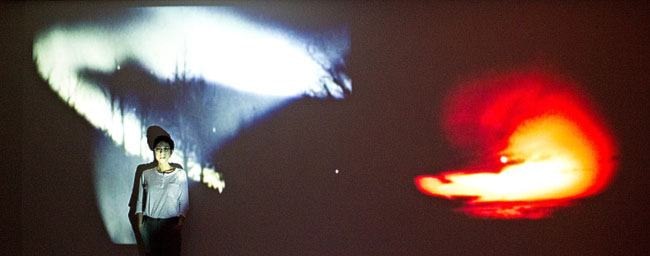We in the North like to brag about our northern lights. When the daylight fades and the cold sets in, we look to the skies for those shifting curtains of green and purple light that make this part of the world so special.
But for a brief time, over 50 years ago, the aurora was stolen from us.
On July 9, 1962, people in Hawaii and all across the Pacific Ocean were treated to an auroral display that dwarfed our northern lights - all thanks to a nuclear bomb launched into space.
Fifty years later, video footage of the explosion, known as Starfish Prime, was declassified. That’s when Nicole Liao saw it for the first time, and it captured her imagination.
“I was struck by the enormity of the act,” she said. “There’s something quite irrational about it.”
Now, Liao is opening a new exhibit about the aurora and the nuclear bomb in the ODD Gallery of the Klondike Institute of Art and Culture in Dawson City. The exhibit, called Against the Day, juxtaposes video of the northern lights and the high-altitude nuclear testing, and displays photos and prints from old books that document early auroral research.
She said the exhibit explores how we try to understand mysterious natural phenomena like the northern lights.
“I think we’re always trying to push the limits of what we know in the universe,” she said. “As human beings, we’re just naturally curious. I think it’s within our nature to go to the limit, but at the same time, I think there’s something self-destructive about it.”
The nuclear test in the summer of 1962 certainly could have been destructive. Starfish Prime was the largest ever man-made nuclear explosion in space.
Ultimately, the explosion helped scientists understand electromagnetic physics and radiation around the Earth. But at the time, no one really knew what would happen.
Starfish Prime was one of a series of bombs launched into space during the Cold War. An American physicist named James A. Van Allen had just discovered that layers of charged particles surround the Earth, in what are now called Van Allen radiation belts.
The U.S. military believed that nuclear bombs could be used to disrupt or blow up these Van Allen belts, or somehow use them as a weapon against the Soviet Union.
So on July 9, 1962, a 1.45-megaton hydrogen bomb was launched about 400 kilometres into space from Johnston Island in the Pacific Ocean. The weapon was 100 times more powerful than the atomic bomb dropped on Hiroshima.
And the effect was dramatic. Particles from the explosion drifted down into the Earth’s atmosphere, where they interacted with oxygen and nitrogen to produce light displays that were seen for thousands of kilometres around the blast. Hotels in Hawaii reportedly planned rooftop parties to watch the show.
But there were other consequences, too. An electromagnetic pulse from the blast knocked out electricity and telephone service in Hawaii. Streetlights were knocked out and burglar alarms were set off.
At least six or seven satellites were also damaged by radiation from the blast. A year later, U.S. President John F. Kennedy and Soviet Premier Nikita Khrushchev banned any further nuclear testing in space.
But the photos and videos remain. Liao said one of the main features of her exhibit is a looping video on a split screen. One half of the screen shows footage of the explosion. The other half shows part of a National Film Board documentary called “The Northern Lights.”
Liao’s exhibit also includes older photographs and text from early auroral research, some from the turn of the 20th century.
“Part of my research meant going back to these early… textbooks by these leading scientists who were trying to describe these electrical phenomena.”
She hopes the exhibit will give people “another dimension of understanding” of how this work was conducted, and how the early research laid the groundwork for Starfish Prime.
Liao is originally from Calgary and now lives in Toronto. This is her first visit to the Yukon, but she said she wanted to open the exhibit here because of Yukoners’ connection with the northern lights.
“I’m really happy to have this show happen in the Yukon,” she said. “I think it’ll be really special here.”
The exhibit opens on Thursday, Jan. 21 at the ODD Gallery with an artist talk at 7:30 p.m. It will run until Feb. 27.
Contact Maura Forrest at
maura.forrest@yukon-news.com
